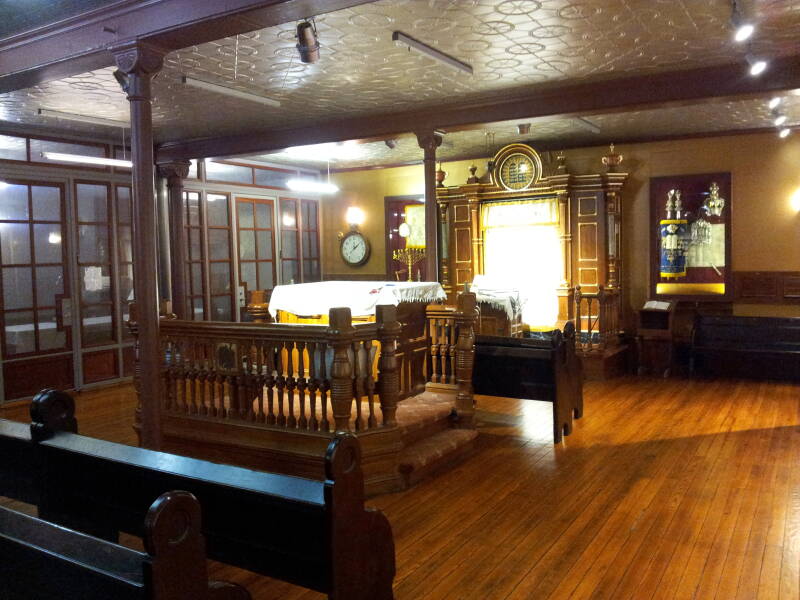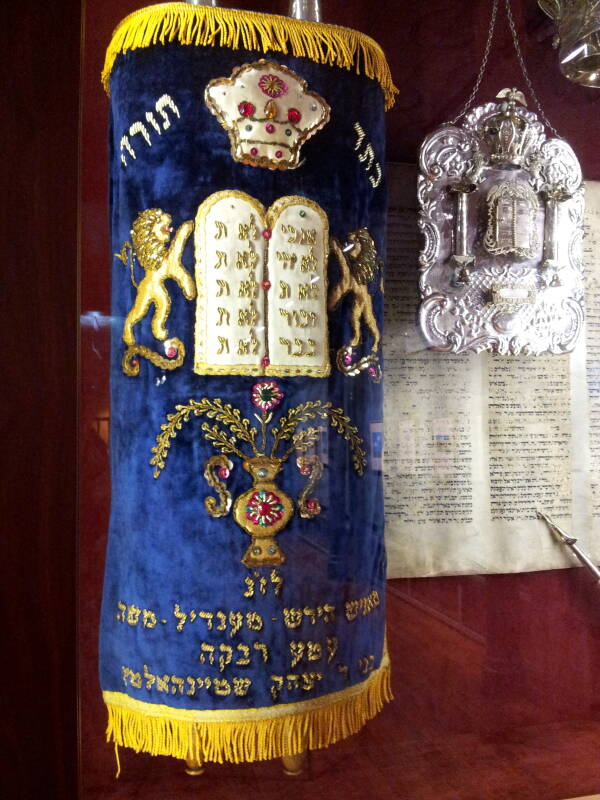
Synagogue Architecture and Furnishings
Architecture
There is no specific "synagogue architecture".
A Jewish
house of worship can take any form, and any enclosed
space can be used as a synagogue.
A custom-built synagogue tends to look like the houses
of worship of other faiths in the area.
Synagogue is actually a Greek word,
συναγωγή,
meaning "assembly".
In Hebrew it might be called a Bet Kenesset
or "House of Assembly",
or a Bet Tefila or "House of Prayer."
The Ashkenazi Jews from Central and Eastern Europe simply
call it by the Yiddish word שול or
shul,
based on the German word for "school".
The Temple
The Temple Mount in Jerusalem was the focus of Jewish worship. The Hebrew Bible says that King Solomon built the First Temple in 957 BCE. It was built to a design similar to Egyptian temples and housed the Ark of the Covenant. It was sacked by the Egyptians and then the Assyrians. Then Nebuchadnezzar II, king of the Neo-Babylonian Empire, destroyed it along with the rest of the city in 586 BCE.
Cyrus the Great, founder of the Achaemenid Empire, authorized the construction of the Second Temple in 538 BCE. It was completed in 515 BCE under his successor, Darius the Great. Alexander the Great came close to destroying it in 332 BCE. Herod the Great renovated and expanded it around 20 BCE. But then the Roman Empire besieged Jerusalem and destroyed the Temple in 70 CE. After a following revolt in the 130s, the Romans banned Jews from Jerusalem.
While there was a Temple, it was where daily morning and afternoon offerings and sacrifices were carried out, the Psalms were recited, and there was a daily prayer service. Today's Orthodox Jewish services mention the sacrifices carried out in the Temple and call for its restoration.
I think it's right to say that from the Orthodox point of view, there is no longer a Temple and maybe it should be rebuilt. Meanwhile, the Reform movement now refers to their assembly halls as temples. Not The Temple, but a local temple.
Synagogues
Religious leaders formalized Jewish prayers during the Babylonian captivity of 586-537 BCE. Any Jewish individual or group can build a synagogue. There were synagogues long before the Second Temple was destroyed. Early synagogues dating to the 3rd century BCE have been found in Egypt. A minyan or מִנְיָן of ten men can assemble for group prayers in any space. A room or small building used for group prayer meetings is called a shtiebel or שטיבל. Synagogues, down to the scale of the shtiebel, supplemented but did not replace the Temple in Jerusalem.
As for dedicated synagogue structures, the architecture isn't distinctive or regulated. Synagogues tend to resemble their surroundings. The earliest synagogues looked like the temples of other religions of the eastern Roman Empire. Synagogues built in medieval Europe looked like Gothic churches. Synagogues in China resemble Chinese temples. It's the internal furnishings that make a space a synagogue.
Furnishings
There are four things you will always find in a synagogue: the Torah itself, a Torah ark (Aron Kodesh) in which it is stored, a raised platform (bima) with a table where the Torah is read, and a continually lit lamp or lantern (ner tamid).
Torah / תּוֺרָה
The Torah contains the first five books of the Hebrew Bible — Genesis (Bereshit), Exodus (Shemot), Leviticus (Vayikra), Numbers (Bamidbar), and Deuteronomy (D'varim). Tradition credits Moses with writing all of it, except of course for the last eight verses that describe his death and burial. The majority of scholars believe that it took written form during the Babylonian exile.
The Torah is hand-written in Hebrew on parchment which is then wound into a scroll. It contains 304,805 stylized letters written without a single error, in 42 lines of text per column. A specified section is read every Sabbath (Saturday) morning so the entire Torah is read every year. Ezra the Scribe established the regular communal reading of the Torah when the Jewish people returned from the Babylonian captivity around 537 BCE. Current tradition maintains that Orthodox Judaism has preserved a Torah-reading procedure unchanged since the destruction of the Second Temple in 70 CE.
Amazon
ASIN: B00LD6ZXM0
Amazon
ASIN: B00KTKKSS0
Aron Kodesh / ארון קודש
The Aron Kodesh, ארון קודש in Hebrew, is the Torah Ark, a special cabinet in which the Torah scrolls are stored. Unless the architecture prohibits this somehow, the Torah Ark is placed so that to face it is to face toward Jerusalem, at least symbolically. The Lower East Side is in the Western Hemisphere, so the Torah Ark is usually placed on the east wall. Spherical trigonometry is disregarded. A great circle path from New York to Jerusalem would start on a heading of about 53°, much closer to northeast than due east.
The Torah Ark is a reminder of the Ark of the Covenant, which held the tablets with the Ten Commandments. It and the façade of the building often bear a symbol representing the tablets of the Ten Commandments. The Ark is the holiest spot in the synagogue, analogous to the Holy of Holies in the Temple.
The parochet or פרוכת is an ornate curtain which typically covers the opening.
Bima / בּימה
The bima, בּימה in Hebrew, gets its name from the ancient Greek βῆμα, a speaker's platform used in courts of law and to address the public. The Temple in Jerusalem contained a platform elevated by two or three steps, and synagogues recreate this. It is at the center of an Orthodox synagogue.
Early Christian church architecture picked up the idea of a ceremonial raised platform. The bema continues to be the name for the sanctuary in Orthodox Christian architecture — the area with the altar behind the iconostasion, the soleas or raised pathway in front of it, and the ambo in front of the Holy Doors and projecting into the nave. See Ιερό Βήμα, σόλιον, and αμβων in Greek; and вима, солея, and амвон in Russian. The deacon leads the litanies and the priest delivers the sermon and distributes Holy Communion from the raised bema.
In western Christianity the bema evolved into the πρεσβυτέριος or presbytery, or chancel.

Small sanctuary in the lower floor of the Eldridge Street Synagogue. Bima with the table for reading the Torah, and the Torah Ark at the front.
Ner Tamid / נר תמיד
The Ner Tamid, נר תמיד in Hebrew, is the Eternal Light, a reminder of the miraculously persistent western lamp of the menorah in the Temple in Jerusalem. It is a continuously lit lamp, usually electrical these days. It hangs in front of the Torah Ark.
An Orthodox synagogue, like those seen here, often have a mechitzah or partition dividing the men from the women, with the women in back. That is, unless there is a separate balcony for the women. The first picture below is taken from one end of the partition, next to one end of the rear-most men's bench.
The German Reform movement beginning in the early 1800s changed the appearance of the synagogue, and later the form of the service itself, in an effort to remain Jewish while joining the host society. For example, the bima in a Reform synagogue is typically at the front, next to the Torah Ark.

The Ner Tamid hangs in front of the Torah Ark or Aron Kodesh,, which is topped with a representation of the Ten Commandments kept in the original Ark of the Covenant.

Torah in a velvet wrapper.

Yad or Torah pointer.
The yad or יד, literally "hand", is a ritual pointer used while reading the Torah.
The Torah is made from parchment, which does not absorb ink and is easily damaged. Also, touching the parchment renders you ritually impure. The yad can be made from anything, but silver as seen here is common, especially for the hand-like tip.